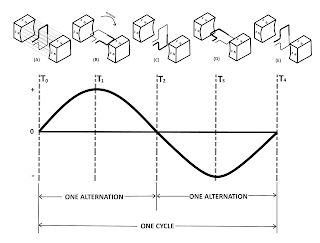Alternating Current - Part 2

By Tim Tolbert Continued from Alternating Current - Part 1 ... Frequency The number of cycles of AC per second is referred to as the Frequency , and is measured in Hertz. Most AC equipment are rated by frequency as well as by voltage and current. A cycle consists of two complete alternations in a period of time. The term HERTZ (Hz) has been designated to indicate one cycle per second. If one cycle per second is one hertz, then 100 cycles per second are equal to 100 hertz, and so on. In the previous example above, if the loop makes one complete revolution each second, the generator produces one complete cycle of AC during each second (1 Hz). Increasing the number of revolutions to two per second will produce two complete cycles of AC per second (2 Hz). The number of complete cycles of alternating current or voltage completed each second is referred to as the Frequency . Frequency is always measured and expressed in hertz. Alternating-current frequency is an important term to un




